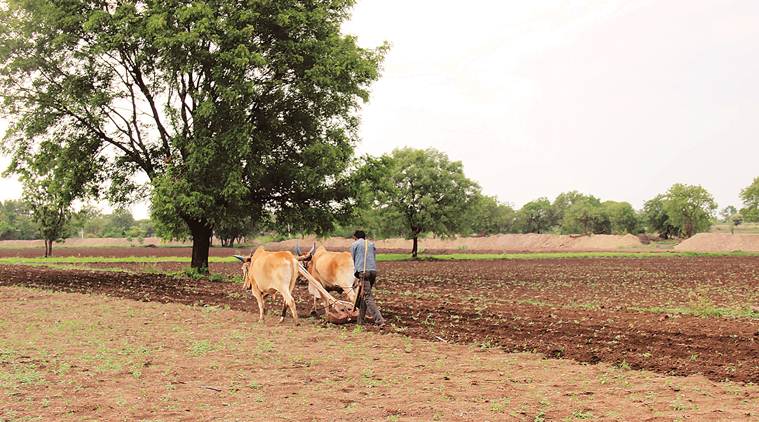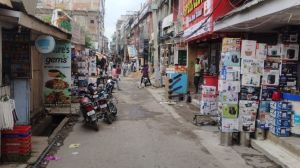Stay updated with the latest - Click here to follow us on Instagram
Collateral benefit: Soyabean farmers see hope from Sino-US trade tensions
China allowing imports from India can help prop up crop prices ahead of Madhya Pradesh state elections.
 A soyabean farmer at a village in Maharashtra’s Beed district. (Archive)
A soyabean farmer at a village in Maharashtra’s Beed district. (Archive)
Lalasaheb Deshmukh, last year, grew tur (pigeon-pea) on 10 and soyabean on 30 out of his total 65 acres of farmland. In the current season, he hasn’t planted a single acre of the pulse crop and simply raised his soyabean area to 40 acres, while dedicating 15 acres to sugarcane and maintaining mango and guava orchards on the remaining holding.
The 48-year-old from Katpur village of Maharashtra’s Latur district — India’s second largest soyabean area after Ujjain in Madhya Pradesh (MP) — has good reasons for his decision. Soyabean and tur yields are more or less the same, at 6-7 quintals per acre. But soyabean takes just 90-100 days to mature, as against 160-180 days for tur. And the real clincher is prices.
Last year, Deshmukh’s average realisation from tur was a mere Rs 4,000 per quintal, below even the Centre’s minimum support price (MSP) of Rs 5,450, leave alone the Rs 9,000-plus levels during harvesting season of January-February 2016. By contrast, he got an average Rs 3,500 per quintal from soyabean, more than the MSP of not just the Rs 3,050 for 2017-18, but also the Rs 3,399 that the Narendra Modi government has declared for the current year. “I did not sell immediately after harvesting towards end-September/early-October, when Latur market prices were Rs 2,500-2,600 per quintal. Instead, I held on to my crop and took it to the mandi only from January and sold right till March,” says Deshmukh.
This time, he intends to start selling earlier, while being sure of prices ruling above the MSP. How is he so confident? “You see, there is this trade war going on between the US and China. China is the world’s biggest soyabean importer and buys massive quantities from the US. With the current tensions, it will begin sourcing from India, boosting demand for our crop,” explains Deshmukh, who has been closely tracking media reports on the subject.
China, in the 2016-17 marketing year (October-September), imported 93.49 million tonnes (mt) of soyabean, which included 45.34 mt from Brazil, 36.84 mt from the US and 6.67 mt from Argentina. India last exported around 0.3 mt of soyabean meal to China in 2010-11. The latter has stopped purchases from India since January 2012, while imposing non-tariff barriers citing pest and disease concerns. But from this July, China has not only slapped a 25 per cent duty on US soyabeans, but also removed all tariffs on import of oilseed and meal from India.
The Indian government and industry are currently in talks with the Chinese authorities for resolving the issues relating to quarantine restrictions. It remains to be seen whether a breakthrough will happen by the time the new crop arrives in the market. Politically, too, that is important, as Assembly elections in MP – the country’s top soyabean producer — are due in November-December. Good crop prices can bolster the ruling Bharatiya Janata Party’s prospects, especially in the western Malwa-Nimar and Bhopal-Hoshangabad division regions.
Right now, farmers like Deshmukh are optimistic about prices, partly also justified by the low carryover stocks from the 2017-18 crop. The Indore-based Soybean Processors Association of India (SOPA) has projected opening stocks for the coming year from October at 0.25 mt, compared to 1.3 mt in 2017-18. That, plus the China demand factor, is what is keeping bullish hopes alive.
However, on the bearish side, the very prospect of better price realisations has led farmers to ramp up plantings this time. SOPA has estimated the total soyabean crop area at 111.734 lakh hectares (lh), a 10 per cent jump over the 101.561 lh in 2017-18. Sowing is up in all the major growing states: MP (from 50.10 lh to 54.10 lh), Maharashtra (34.484 lh to 38.692 lh), Rajasthan (9.245 lh to 10.455 lh), Karnataka (2.71 lh to 3.18 lh) and Andhra Pradesh-Telangana (1.652 lh to 1.78 lh).
According to SOPA’s first field survey report released on Friday, the overall crop condition so far is normal with no major pest and disease attacks. While some moisture stress has reported in parts of MP, Maharashtra and Rajasthan, causing poor vegetative growth, the recovery of rains this month will ensure no significant yield losses. But there are concerns about the quality of seed used for sowing this time, which, some farmers believe, might affect yields. That, in turn, has had to do with the low realisations in recent years, dissuading seed growers from undertaking production. Only 20-25 per cent of seeds planted in Maharashtra this time are said to have been of “certified” quality.
Dhanraj Gund, a farmer from Padoli village in Osmananbad district, has planted soyabean on his entire 18-acre holding. But the seeds have failed to germinate in all but six acres. “I used the grain from last year’s crop as seed. New seeds were not available,” he complains. That is also echoed by Keshav Awarde from Umari village in Nanded district’s Ardhapur taluka, who had taken cotton on four out of his 8-acre holding last year. Following a pink bollworm attack destroying 80 per cent of his cotton crop, Awarde sowed soyabean on five acres this season, apart from turmeric on two and sugarcane on the remaining one acre. But he couldn’t get good seeds and had to use the grain saved from the previous crop.
Given all these, it’s not surprising that nobody is able to make reliable forecasts of the crop size or even the likely demand-and-price scenario in the months ahead. Soyabean in Indore is at present quoting at Rs 3,450 per quintal, while futures prices at the National Commodity & Derivatives Exchange are trading flat at Rs 3,326-3,378 for the October, November and December contracts.
For every quintal (100 kg) of soyabean crushed, processors recover 18 kg of crude oil. The rest 82 kg constitutes the de-oiled protein rich cake and other solid extractions, commonly known as meal. Soyabean meal has traditionally been an exportable commodity, but the business has gone through tumultuous times in the past few years.
In 2012-13 and 2013-14 (April-March), India exported 44.84 lakh tonnes (lt) and 39.23 lt of soyabean meal, valued at Rs 13,357.49 crore and Rs 13,246.29 crore, respectively. But in the subsequent two fiscals, these collapsed to 13.73 lt (Rs 4,515.34 crore) and 3.56 lt (Rs 1,287.82 crore), respectively. In the last two years, exports have recovered a tad to 11.32 lt (Rs 3,185.74 crore) and 16.65 lt (Rs 4,340.45 crore).
For the likes of Lalasaheb Deshmukh and Dhanraj Gund, the opening of the Chinese market is what can provide a much-needed manna from heaven today.








